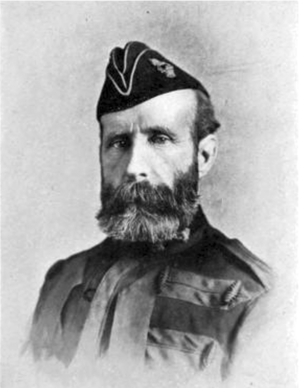Acheson Irvine facts for kids
Quick facts for kids
Acheson Irvine
|
|
|---|---|
 |
|
| Commissioner of the Royal Canadian Mounted Police | |
| In office 1880–1886 |
|
| Preceded by | James Macleod |
| Succeeded by | Lawrence Herchmer |
Acheson Gosford Irvine (born December 7, 1837 – died January 8, 1916) was an important leader in early Canadian history. He served as the Commissioner of the North-West Mounted Police (NWMP) from 1880 to 1886. The NWMP was the police force that helped keep peace and order in Canada's western territories. It later became the famous Royal Canadian Mounted Police (RCMP).
Contents
Early Life and Career
Acheson Irvine was born in Lower Canada in 1837. His father, John George Irvine, was a captain in the Royal Quebec volunteers. Acheson Irvine joined the North-West Mounted Police in 1876. He quickly became the Assistant Commissioner. Just four years later, in 1880, he was promoted to Commissioner. This made him the top leader of the NWMP.
Role in the North-West Rebellion
Irvine played a key role during the North-West Rebellion of 1885. This was a conflict between the Canadian government and the Métis people and their First Nations allies.
Trouble at Fort Carlton
On March 17, 1885, Irvine received an urgent message. Superintendent Leif Newry Fitzroy Crozier warned him of trouble near Fort Carlton. Reinforcements were needed right away.
The next day, March 18, Irvine left Regina with 100 police officers. They traveled to Prince Albert, Saskatchewan, arriving on March 25.
The Battle of Duck Lake
On March 26, Irvine headed towards Fort Carlton with 83 police and 25 civilian volunteers. Before he arrived, a fight broke out at Duck Lake. This was near Batoche.
Superintendent Crozier's NWMP forces fought against a group of Métis and First Nations warriors. This group was led by Gabriel Dumont. The NWMP suffered losses in this battle.
Retreat from Fort Carlton
On March 27, Irvine reached Fort Carlton. He quickly decided that the fort could not be defended. He ordered his troops to leave the fort and return to Prince Albert. The police and volunteers made it back safely. However, Fort Carlton burned down during the evacuation.
After these events, General Middleton publicly criticized Irvine. He felt Irvine should have attacked Batoche instead of retreating.
Later Life and Legacy
After his time as Commissioner, Acheson Irvine continued to serve. From 1882 to 1886, he was a member of the executive council of the North-West Territories. This council helped govern the region.
In 1886, Irvine retired from the NWMP. He then became the warden of the Stony Mountain Penitentiary in Manitoba. This was a large prison. In 1902, he received the Imperial Service Order. This award recognized his long and dedicated service to the British Empire.
The RCMP Ship Irvine
In 1945, a ship was named after Acheson Irvine. This was an RCMP Commissioner-Class patrol vessel called the Irvine. It had originally been a minesweeper in the Royal Canadian Navy. In 1962, the RCMP sold the ship. It was then changed into a yacht called the Miriana. Sadly, the Miriana sank in Montego Bay, Jamaica, in May 1971.

